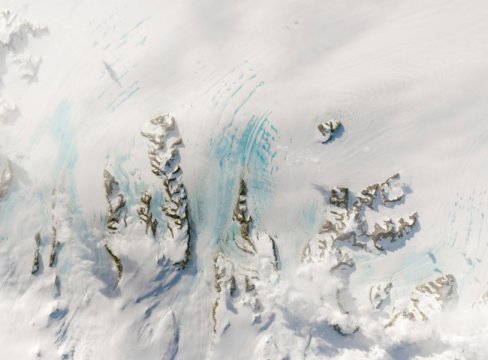[ad_1]
The Antarctic Peninsula is the northernmost part of Earth’s coldest continent, making it particularly vulnerable to a changing global climate. Surface melting of snow and ice initiated the breakup of the peninsula’s northernmost Larsen A ice shelf in 1995, followed in 2002 by the Larsen B ice shelf to the south, which lost a section roughly the size of Rhode Island.
New University of Maryland-led research shows that the Larsen C ice shelf — the fourth largest ice shelf in Antarctica, located just south of the former Larsen B shelf — experienced an unusual spike in late summer and early autumn surface melting in the years 2015 to 2017. The study, spanning 35 years from 1982 to 2017, quantifies how much of this additional melting can be ascribed to warm, dry air currents called foehn winds that originate high in the peninsula’s central mountain range.
The study further shows that the three-year spike in foehn-induced melting late in the melt season has begun to restructure the snowpack on the Larsen C ice shelf. If this pattern continues, it could significantly alter the density and stability of the Larsen C ice shelf, potentially putting it at further risk to suffer the same fate as the Larsen A and B shelves.
The researchers used two different methods to quantify patterns of foehn-induced melt from climate model outputs that correspond to real-world satellite observations and weather station data. They published their findings on April 11, 2019 in the journal Geophysical Research Letters.
“Three years doesn’t make a trend. But it’s definitely unusual that we are seeing enhanced foehn winds and associated melting in late summer and early autumn,” said Rajashree Tri Datta, a faculty assistant at UMD’s Earth System Science Interdisciplinary Center and the lead author of the research paper. “It’s unusual that we’re seeing increased foehn-induced melt in consecutive years — especially so late in the melt season, when the winds are stronger but the temperatures are usually cooling down. This is when we expect melting to end and the surface to be replenished with snow.”
Enhanced surface melting causes water to trickle into the underlying layers of firn — or uncompacted, porous snow — in the upper layers of the ice sheet. This water then refreezes, causing the normally porous, dry firn layers to become denser. Eventually, the firn layers can become too dense for water to enter, leading to a buildup of liquid water atop the ice shelf.
“With enhanced densification, the ice enters the next warm season with a very different structure. Our modeling results show that, with less open space for the surface water to filter into, runoff increases year after year,” said Datta, who also has an appointment at NASA’s Goddard Space Flight Center. “The dominant theory suggests that enhanced densification led to the fracture of the Larsen A and B shelves. Despite an overall decrease in peak summer melt over the last few years, episodic melting late in the melt season could have an outsized impact on the density of the Larsen C ice shelf.”
As foehn winds race down the colder eastern slopes of the Antarctic Peninsula’s central mountain range, they can raise air temperatures by as much as 30 degrees Fahrenheit, producing localized bursts of snowmelt. According to Datta, these winds exert their greatest effects at the bases of glacial valleys. Here, where the feet of the glaciers adjoin the Larsen C ice shelf, foehn winds stand to destabilize some of the most fragile and critical structures in the system.
“The Larsen C ice shelf is of particular interest because it’s among the most vulnerable in Antarctica,” Datta explained. “Because it’s a floating ice shelf, a breakup of Larsen C wouldn’t directly lead to a rise in global mean sea level. However, the ice shelf does brace against the flow of the glaciers that feed it. So if Larsen C goes, some of these glaciers will be free to accelerate their rate of flow and melt, which will result in a rise in global sea level.”
Story Source:
Materials provided by University of Maryland. Note: Content may be edited for style and length.
[ad_2]















